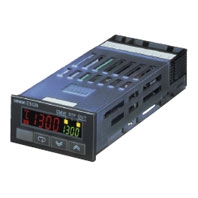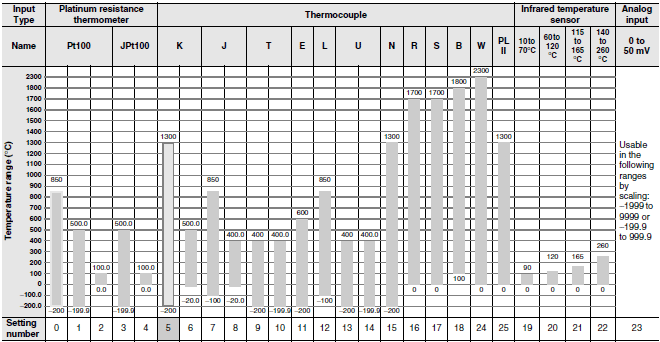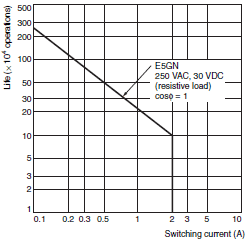E5GN
Basic-type Digital Temperature Controller (48 x 24 mm)

New 48 x 24-mm Basic Temperature Controller with Enhanced Functions and Performance. Improved Indication Accuracy and Preventive Maintenance Function.
- Features
- Lineup
- Specifications
- Dimensions
- Catalog / Manual / CAD / Software
last update: August 6, 2015
Ratings
| Power supply voltage | No D in model number: 100 to 240 VAC, 50/60 Hz
D in model number: 24 VAC, 50/60 Hz; 24 VDC |
|
|---|---|---|
| Operating voltage range | 85% to 110% of rated supply voltage | |
| Power
consump- tion |
E5GN
Screw terminal block |
100 to 240 VAC: 5.5 VA (max.)
24 VAC/VDC: 3 VA/2 W (max.) |
| E5GN-[]-C
Screwless clamp terminal block |
100 to 240 VAC: 5.5 VA (max.)
24 VAC/VDC: 3 VA/2 W (max.) |
|
| Sensor input | Models with temperature inputs
Thermocouple: K, J, T, E, L, U, N, R, S, B, W, or PL II Platinum resistance thermometer: Pt100 or JPt100 Infrared temperature sensor (ES1B): 10 to 70°C, 60 to 120°C, 115 to 165°C, or 140 to 260°C Voltage input: 0 to 50 mV |
|
| Models with analog inputs
Current input: 4 to 20 mA or 0 to 20 mA Voltage input: 1 to 5 V, 0 to 5 V, or 0 to 10 V |
||
| Input impedance | Current input: 150 Ω max., Voltage input: 1 MΩ min. (Use a 1:1 connection when connecting the ES2-HB.) | |
| Control method | ON/OFF control or 2-PID control (with auto-tuning) | |
| Control
outputs |
Relay output | SPST-NO, 250 VAC, 2 A (resistive load), electrical life: 100,000 operations, minimum applicable load: 5 V,
10 mA |
| Voltage output
(for driving SSR) |
Output voltage: 12 VDC ± 15% (PNP), max. load current: 21 mA, with short-circuit protection circuit | |
| Current output | 4 to 20 mA DC/0 to 20 mA DC, load: 500 Ω max., resolution: approx. 10,000 | |
| Auxiliary
outputs |
Number of outputs | 1 or 2 max. (Depends on the model.) |
| Output
specifications |
Relay output: SPST-NO, 250 VAC, 2 A (resistive load), electrical life: 100,000 operations, minimum
applicable load: 5 V, 10 mA |
|
| Event
inputs |
Number of inputs | 2 |
| External contact
input specifications |
Contact input: ON: 1 kΩ max., OFF: 100 kΩ min. | |
| Non-contact input: ON: Residual voltage: 1.5 V max., OFF: Leakage current: 0.1 mA max. | ||
| Current flow: Approx. 7 mA per contact | ||
| Setting method | Digital setting using front panel keys | |
| Indication method | 11-segment digital display and individual indicators (7-segment display also possible)
Character height: PV: 7.5 mm, SV: 3.6 mm |
|
| Multi SP | Up to four set points (SP0 to SP3) can be saved and selected using event inputs, key operations, or serial
communications. |
|
| Bank switching | Not supported | |
| Other functions | Manual output, heating/cooling control, loop burnout alarm, SP ramp, other alarm functions, heater burnout
detection (including SSR failure and heater over current detection), 40% AT, 100% AT, MV limiter, input digital filter, self-tuning, temperature input shift, run/stop, protection functions, control output ON/OFF counter, extraction of square root, MV change rate limit, logic operations, PV/SV status display, simple program, automatic cooling coefficient adjustment |
|
| Ambient operating temperature | -10 to 55 °C (with no condensation or icing), for 3-year warranty: -10 to 50 °C | |
| Ambient operating humidity | 25% to 85% | |
| Storage temperature | -25 to 65 °C (with no condensation or icing) | |
Input Ranges
Thermocouple/Platinum Resistance Thermometer (Universal Inputs)

Shaded settings are the default settings.
The applicable standards for the input types are as follows:
K, J, T, E, N, R, S, B: JIS C 1602-1995, IEC 584-1
L: Fe-CuNi, DIN 43710-1985
U: Cu-CuNi, DIN 43710-1985
W: W5Re/W26Re, ASTM E988-1990
JPt100: JIS C 1604-1989, JIS C 1606-1989
Pt100: JIS C 1604-1997, IEC 751
PL II: According to Platinel II electromotive force charts from BASF (previously Engelhard)
Models with Analog Inputs
| Input Type | Current | Voltage | |||
|---|---|---|---|---|---|
| Input specification | 4 to 20 mA | 0 to 20 mA | 1 to 5 V | 0 to 5 V | 0 to 10 V |
| Setting range | Usable in the following ranges by scaling: -1999 to 9999, -199.9 to 999.9, -19.99 to 99.99 or -1.999 to 9.999 |
||||
| Setting number | 0 | 1 | 2 | 3 | 4 |
Shaded settings are the default settings.
Alarm Outputs
Auxiliary outputs are allocated for alarms. ON delays and OFF delays (0 to 999 s) can also be specified.
Note: For models with heater burnout, SSR failure, and heater overcurrent detection, alarm 1 will be an OR output of the
alarm selected from the following alarm types and the alarms for heater burnout, SSR failure, and heater
overcurrent. To output only a heater burnout alarm, SSR failure alarm, and heater overcurrent alarm for alarm 1, set
the alarm type to 0 (i.e., no alarm function).
| Set
value |
Alarm type | Alarm output operation | Description of function | |
|---|---|---|---|---|
| When alarm value
X is positive |
When alarm value
X is negative |
|||
| 0 | Alarm function OFF | Output OFF | No alarm | |
| 1 *1 | Upper- and lower-limit |  |
*2 | Set the deviation in the set point by
setting the alarm upper limit (H) and alarm lower limit (L). |
| 2 | Upper-limit |  |
 |
Set the upward deviation in the set point
by setting the alarm value (X). |
| 3 | Lower-limit |  |
 |
Set the downward deviation in the set
point by setting the alarm value (X). |
| 4 *1 | Upper- and lower-limit
range |
 |
*3 | Set the deviation in the set point by
setting the alarm upper limit (H) and alarm lower limit (L). |
| 5 *1 | Upper- and lower-limit with
standby sequence |
 |
*4 | A standby sequence is added to the
upper- and lower-limit alarm (1). *6 |
| 6 | Upper-limit with standby
sequence |
 |
 |
A standby sequence is added to the
upper-limit alarm (2). *6 |
| 7 | Lower-limit with standby
sequence |
 |
 |
A standby sequence is added to the
lower-limit alarm (3). *6 |
| 8 | Absolute-value upper-limit |  |
 |
The alarm will turn ON if the process
value is larger than the alarm value (X) regardless of the set point. |
| 9 | Absolute-value lower-limit |  |
 |
The alarm will turn ON if the process
value is smaller than the alarm value (X) regardless of the set point. |
| 10 | Absolute-value upper-limit
with standby sequence |
 |
 |
A standby sequence is added to the
absolute-value upper- limit alarm (8). *6 |
| 11 | Absolute-value lower-limit
with standby sequence |
 |
 |
A standby sequence is added to the
absolute-value lower-limit alarm (9). *6 |
| 12 | LBA (alarm 1 type only) | --- | Refer to Data Sheet. | |
| 13 | PV change rate alarm | --- | Refer to Data Sheet. | |
expressed as "L" and "H."
*2. Set value: 1, Upper- and lower-limit alarm

*3. Set value: 4, Upper- and lower-limit range

For Upper- and Lower-Limit Alarm Described Above
• Case 1 and 2
Always OFF when the upper-limit and lower-limit hysteresis overlaps.
• Case 3: Always OFF
*5. Set value: 5, Upper- and lower-limit with standby sequence
Always OFF when the upper-limit and lower-limit hysteresis overlaps.
*6. Refer to the E5CN/E5AN/E5EN/E5GN Digital Temperature Controllers User's Manual Basic Type (Cat. No. H156) for
information on the operation of the standby sequence.
*7. Refer to the E5CN/E5AN/E5EN/E5GN Digital Temperature Controllers User's Manual Basic Type (Cat. No. H156) for
information on the loop burnout alarm (LBA).
*8. Refer to the E5CN/E5AN/E5EN/E5GN Digital Temperature Controllers User's Manual Basic Type (Cat. No. H156) for
information on the PV change rate alarm.
Characteristics
| Indication accuracy | Thermocouple: *1
(± 0.3% of indicated value or ± 1 °C, whichever is greater) ± 1 digit max. Platinum resistance thermometer input: (± 0.2% of indicated value or ± 0.8 °C, whichever is greater) ± 1 digit max. Analog input: ± 0.2% FS ± 1 digit max. CT input: ± 5% FS ± 1 digit max. |
|
|---|---|---|
| Influence of temperature
*2 |
Thermocouple input (R, S, B, W, PL II):
(± 1% of PV or ± 10 °C, whichever is greater) ± 1 digit max. Other thermocouple input: *3 (± 1% of PV or ± 4 °C, whichever is greater) ± 1 digit max. Platinum resistance thermometer input: (± 1% of PV or ± 2 °C, whichever is greater) ± 1 digit max. Analog input: (± 1%FS) ± 1 digit max. |
|
| Influence of voltage *2 | ||
| Influence of EMS.
(at EN 61326-1) |
||
| Input sampling period | 250 ms | |
| Hysteresis | Models with thermocouple/platinum resistance thermometer input (universal input): 0.1 to 999.9 EU (in units of 0.1 EU) *4
Models with analog input: 0.01 to 99.99% FS (in units of 0.01% FS) |
|
| Proportional band (P) | Models with thermocouple/platinum resistance thermometer input (universal input): 0.1 to 999.9 EU (in units of 0.1 EU) *4
Models with analog input: 0.1 to 999.9% FS (in units of 0.1% FS) |
|
| Integral time (I) | 0 to 3999 s (in units of 1 s) | |
| Derivative time (D) | 0 to 3999 s (in units of 1 s) *5 | |
| Control period | 0.5, 1 to 99 s (in units of 1 s) | |
| Manual reset value | 0.0 to 100.0% (in units of 0.1%) | |
| Alarm setting range | -1999 to 9999 (decimal point position depends on input type) | |
| Affect of signal source
resistance |
Thermocouple: 0.1°C/Ω max. (100 Ω max.)
Platinum resistance thermometer: 0.1°C/Ω max. (10 Ω max.) |
|
| Insulation resistance | 20 MΩ min. (at 500 VDC) | |
| Dielectric strength | 2,300 VAC, 50 or 60 Hz for 1 min (between terminals with different charge) | |
| Vibration
resistance |
Malfunction | 10 to 55 Hz, 20 2 for 10 min each in X, Y, and Z directions |
| Destruction | 10 to 55 Hz, 0.75-mm single amplitude for 2 hrs each in X, Y, and Z directions | |
| Shock
resistance |
Malfunction | 100 2, 3 times each in X, Y, and Z directions |
| Destruction | 300 2, 3 times each in X, Y, and Z directions | |
| Weight | Controller: Approx. 90 g, Mounting Bracket: Approx. 10 g | |
| Degree of protection | Front panel: IP66, Rear case: IP20, Terminals: IP00 | |
| Memory protection | Non-volatile memory (number of writes: 1,000,000 times) | |
| Setup Tool | CX-Thermo version 4.2 or higher | |
| Setup Tool port | Provided on the side of the E5GN. Connect this port to the computer when using the Setup Tool. An E58-CIFQ1 USB-Serial Conversion Cable is required to connect the computer to the port on the side of the E5GN. *6 | |
| Standards | Approved
standards |
UL 61010-1, CSA C22.2 No. 1010-1 |
| Conformed
standards |
EN 61010-1 (IEC 61010-1): Pollution level 2, overcurrent category II | |
| EMC | EMI: EN 61326-1 *7
Radiated Interference Electromagnetic Field Strength: EN 55011 Group 1, class A Noise Terminal Voltage: EN 55011 Group 1, class A EMS: EN 61326-1 *7 ESD Immunity: EN 61000-4-2 Electromagnetic Field Immunity: EN 61000-4-3 Burst Noise Immunity: EN 61000-4-4 Conducted Disturbance Immunity: EN 61000-4-6 Surge Immunity: EN 61000-4-5 Power Frequency Magnetic Field Immunity: EN 61000-4-8 Voltage Dip/Interrupting Immunity: EN 61000-4-11 |
|
−100°C max., and U and L thermocouples at any temperatures is ±2°C ±1 digit max. The indication accuracy of the B
thermocouple at a temperature of 400°C max. is not specified. The indication accuracy of B thermocouples in the 400
to 800°C range is ±3°C max. The indication accuracy of the R and S thermocouples at a temperature of 200°C max.
is ±3°C ±1 digit max. The indication accuracy of W thermocouples is ±0.3 of PV or ±3°C, whichever is greater, ±1
digit max. The indication accuracy of PL II thermocouples is ±0.3 of PV or ±2°C, whichever is greater, ± 1 digit max.
*2. Ambient temperature: −10°C to 23°C to 55°C, Voltage range: −15% to 10% of rated voltage
*3. K thermocouple at −100°C max.: ±10° max.
*4. “EU” stands for Engineering Unit and is used as the unit after scaling. For a temperature sensor, the EU is °C or °F.
*5. When robust tuning (RT) is ON, the differential time is 0.0 to 999.9 (in units of 0.1 s).
*6. External serial communications (RS-232C or RS-485) and cable communications for the Setup Tool can be used at
the same time.
*7. Industrial electromagnetic environment (EN/IEC 61326-1 Table 2)
USB-Serial Conversion Cable
| Applicable OS | Windows XP/Vista/7/8 |
|---|---|
| Applicable software | CX-Thermo version 4 or higher |
| Applicable models | E5AN/E5EN/E5CN/E5CN-U/E5AN-H/E5EN-H/E5CN-H/E5GN |
| USB interface standard | Conforms to USB Specification 1.1. |
| DTE speed | 38400 bps |
| Connector specifications | Computer: USB (type A plug)
Temperature Controller: Setup Tool port (on bottom of Controller) |
| Power supply | Bus power (Supplied from USB host controller.) |
| Power supply voltage | 5 VDC |
| Current consumption | 70 mA |
| Ambient operating temperature | 0 to 55°C (with no condensation or icing) |
| Ambient operating humidity | 10% to 80% |
| Storage temperature | - 20 to 60°C (with no condensation or icing) |
| Storage humidity | 10% to 80% |
| Altitude | 2,000 m max. |
| Weight | Approx. 100 g |
Conversion Cable.
Communications Specifications
| Transmission line connection method | RS-485: Multipoint RS-232C: Point-to-point |
|---|---|
| Communications | RS-485 (two-wire, half duplex), RS-232C |
| Synchronization method | Start-stop synchronization |
| Protocol | CompoWay/F, SYSWAY, or Modbus |
| Baud rate | 1200, 2400, 4800, 9600, 19200, 38400, or 57600 bps |
| Transmission code | ASCII |
| Data bit length * | 7 or 8 bits |
| Stop bit length * | 1 or 2 bits |
| Error detection | Vertical parity (none, even, odd) Frame check sequence (FCS) with SYSWAY Block check character (BCC) with CompoWay/F or CRC-16 Modbus |
| Flow control | None |
| Interface | RS-485, RS-232C |
| Retry function | None |
| Communications buffer | 217 bytes |
| Communications response wait time | 0 to 99 ms Default: 20 ms |
Setting Level.
Current Transformer (Order Separately) Ratings
| Dielectric strength | 1,000 VAC for 1 min |
|---|---|
| Vibration resistance | 50 Hz, 98 m/s2 |
| Weight | E54-CT1: Approx. 11.5 g, E54-CT3: Approx. 50 g |
| Accessories (E54-CT3 only) | Armatures (2) Plugs (2) |
Heater Burnout Alarms, SSR Failure Alarms, and Heater Overcurrent Alarms
| CT input (for heater current detection) | Models with detection for single-phase heaters: One input |
|---|---|
| Maximum heater current | 50 A AC |
| Input current indication accuracy | ±5% FS ±1 digit max. |
| Heater burnout alarm setting range *1 | 0.1 to 49.9 A (in units of 0.1 A) Minimum detection ON time: 100 ms |
| SSR failure alarm setting range *2 | 0.1 to 49.9 A (in units of 0.1 A) Minimum detection OFF time: 100 ms |
| Heater overcurrent alarm setting range *3 | 0.1 to 49.9 A (in units of 0.1 A) Minimum detection ON time: 100 ms |
assigned to the alarm 1 function will turn ON if the heater current is lower than the set value (i.e., heater burnout
detection current value).
*2. For SSR failure alarms, the heater current will be measured when the control output is OFF, and the output assigned
to the alarm 1 function will turn ON if the heater current is higher than the set value (i.e., SSR failure detection current
value).
*3. For heater overcurrent alarms, the heater current will be measured when the control output is ON, and the output
assigned to the alarm 1 function will turn ON if the heater current is higher than the set value (i.e., heater overcurrent
detection current value).
Electrical Life Expectancy Curve for Relays (Reference Values)

last update: August 6, 2015

